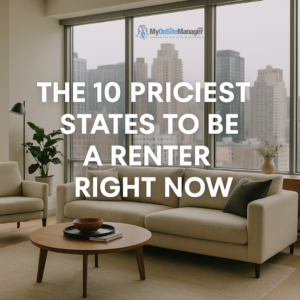Renting is becoming more expensive across the U.S., but in certain states, it’s downright brutal. According to Doxo’s 2024 Household Bill Report, monthly rent in the top 10 priciest states now averages well above the national norm. These high costs aren’t just about location—they reflect a mix of economic forces, housing supply constraints, and lifestyle demand that have converged to create major affordability pressures.
Here’s a breakdown of the states where renters are feeling the most financial strain—and what you should know if you live there or are considering a move.
1. Hawaii – $1,983/month
Paradise comes at a price. Hawaii’s stunning landscapes, strong tourism economy, and limited available land make it the most expensive state to rent in America. Strict zoning laws and geographical limitations severely restrict new construction, which means competition for rentals is fierce. Even modest apartments can demand near-luxury prices.
2. California – $1,927/month
Home to tech giants, world-class cities, and unbeatable weather, California continues to be a rental hot spot—and a costly one. Cities like San Francisco, Los Angeles, and San Diego drive prices up across the state. Incomes might be higher here, but rent still outpaces wages for many middle-income renters. Combine that with local regulations and a long-standing housing shortage, and it’s easy to see why California ranks second.
3. Massachusetts – $1,684/month
With Boston at its center, Massachusetts draws students, professionals, and medical experts alike. The presence of top-tier universities and hospitals boosts rental demand. While rent here isn’t as high as in Hawaii or California, it still reflects a tight housing market with limited availability and increasing costs in Greater Boston and surrounding suburbs.
4. New York – $1,636/month
While New York City grabs the spotlight, rent prices across the entire state are steep. High demand, limited inventory, and a strong job market—particularly in finance, media, and healthcare—keep rent high. Even in upstate areas like Albany and Rochester, prices have crept upward as remote work reshapes demand.
5. New Jersey – $1,629/month
Close proximity to New York City and Philadelphia has made New Jersey a commuter haven—but it comes at a cost. Suburban towns with good school districts and public transit access have seen rents soar. New construction hasn’t kept pace with demand, especially in popular areas like Jersey City and Hoboken.
6. Washington – $1,620/month
The Seattle tech boom has transformed Washington’s rental landscape. Major employers like Amazon and Microsoft have drawn thousands of high-salary workers, while zoning restrictions and environmental regulations have limited new housing supply. This mismatch continues to push prices higher, making Washington one of the costliest states for renters.
7. Maryland – $1,620/month
Maryland benefits from its strategic location near Washington, D.C., and a solid economy driven by government, healthcare, and defense. Suburban hubs like Bethesda and Silver Spring are in high demand, and while Maryland offers a slightly more affordable alternative to D.C. proper, rent is still significantly above the national average.
8. Colorado – $1,510/month (estimated)
Though not listed in the top 7, Colorado consistently ranks high for rental prices. Cities like Denver, Boulder, and Fort Collins have experienced rapid growth over the past decade. With scenic mountain views, booming job markets, and a desirable lifestyle, Colorado attracts both young professionals and retirees—keeping vacancy rates low and rent prices high.
9. Connecticut – Approx. $1,490/month
Often overlooked in national discussions, Connecticut’s rental market is quietly expensive. With close access to New York City, affluent coastal towns, and limited affordable housing stock, rents in places like Stamford and New Haven are well above the national average.
10. Virginia – Approx. $1,460/month
Virginia rounds out the list, thanks to strong rental demand in Northern Virginia, where many residents work in or near D.C. Areas like Arlington and Alexandria are known for sky-high rents, driven by professional demand, proximity to federal agencies, and strong public infrastructure.
Why Rent Is So Expensive in These States
A few key trends are behind these high costs:
- Strong Local Economies
All of these states have robust job markets in fields like tech, healthcare, finance, and government. High wages can push landlords to raise rent, especially when demand is high.
- Low Housing Supply
Many of these areas have strict zoning laws, environmental protections, or limited land, which slows new housing development and limits supply.
- Desirable Lifestyle
Beautiful weather, scenic environments, and strong public amenities make these states especially attractive—whether you’re a digital nomad or a family seeking long-term stability.
Tips for Renters in High-Cost States
If you’re navigating the rental market in one of these states, here are a few strategies that might help:
-
Expand Your Search Radius: Consider renting in nearby suburbs or smaller cities with better value.
-
Find a Roommate: Shared housing is a great way to reduce monthly expenses.
-
Watch for Move-In Deals: In competitive markets, some landlords offer discounts or incentives to secure tenants.
-
Stay Informed About Local Laws: Know your rights regarding rent caps, tenant protections, and eviction notices.
Final Thoughts
As rent prices rise across the country, these ten states are especially challenging for renters. Whether you’re currently living in one or planning a move, it’s essential to understand the forces shaping your local housing market—and how to navigate them with confidence.
Source: The 10 Priciest States To Be a Renter Right Now – Wealth Gang / NewsBreak

